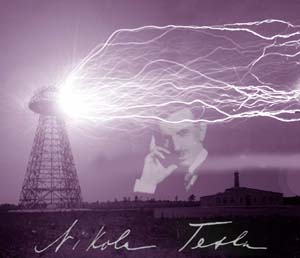
9/1/06
Whether we're talking about mad inventor Nikola Tesla or ancient bad-boy Archimedes, I likes me some Death Rays. Tesla is said to have invented a "teleforce" weapon capable of melting planes at 250 miles out, and Archimedes was supposed to have been able to set fire invading ships with the awesome power of the sun concentrated through a parabolic mirror. Neither has been proven to actually have ever actually existed, and in the case of Archimedes, it has been amply demonstrated (see his link above) that even if the contraption had been real, the logistics behind it would be fantastically complex and dodgy to operate.
 I tried to build my own death ray once, but lacking an engineering degree or any willingness to spend any actual funds, I settled on a potato gun instead. It couldn’t melt airplanes or combust ships, but you should see the neighborhood children scatter when spud-gun-wielding Ryan comes stumbling out of the house drunk with power and whiskey.
I tried to build my own death ray once, but lacking an engineering degree or any willingness to spend any actual funds, I settled on a potato gun instead. It couldn’t melt airplanes or combust ships, but you should see the neighborhood children scatter when spud-gun-wielding Ryan comes stumbling out of the house drunk with power and whiskey.Totally kick-ass death rays may still be a thing of the future, but the same sort of technology is being used for a new type of solar power. Solar thermal power isn’t as popular as solar photovoltaics (PV-those slick panels that turn light into power) mostly because it needs heat as well as light to generate energy, and therefore you have to have a mostly sunny, hot area to install the generators. Like, Nevada, for instance. But damn if they don’t pack a punch.
 Solar One is the name of the Nevada project, and it harnesses death-ray technology to create electricity. A parabolic mirror funnels incoming heat and light and concentrates it into a tube which contains some magical kind of oil which I'm too lazy to actually research. The oil is heated to over 700◦F by this process and, I guess, some rabbit pops out the other end with a big bag of electricity. Okay so I don't know all the ins and outs of the process (not an engineer, remember?) but this bad boy can crank out 64 megawatts during the hottest part of the Nevada day. That's enough juice to power 40,000 homes in Las Vegas, and even the largest PV array, located in Germany, can only muster a paltry 10 megawatts or so which, I guess, could power one video slot machine for an hour.
Solar One is the name of the Nevada project, and it harnesses death-ray technology to create electricity. A parabolic mirror funnels incoming heat and light and concentrates it into a tube which contains some magical kind of oil which I'm too lazy to actually research. The oil is heated to over 700◦F by this process and, I guess, some rabbit pops out the other end with a big bag of electricity. Okay so I don't know all the ins and outs of the process (not an engineer, remember?) but this bad boy can crank out 64 megawatts during the hottest part of the Nevada day. That's enough juice to power 40,000 homes in Las Vegas, and even the largest PV array, located in Germany, can only muster a paltry 10 megawatts or so which, I guess, could power one video slot machine for an hour.How much does this Solar One’s energy production cost? At the moment it's rather steep. It breaks down like this:
Electrical Production Price per Kilowatt hour
Oil and Natural Gas.........................................5-7¢
Hydrodynamics……………………………………..7-8¢
Wind Power…………………………………………...9¢
Solar One…..…………………………………………..15¢
PV (solar panels)……………………………………..30¢
As you can see, while still half the price of "conventional" solar power, Solar One is still a great deal pricier than good, old fashioned ancient fossils from the earth. Whereas PV can be used almost anywhere, Solar One also has the drawback that it has to be in someplace pretty hot and sunny almost all the time. However, up until the Bush Administration cut funding for this and other alternative fuel projects, Solar One was hoping to quickly get down to costs comparable to oil and gas. But, sadly, despite the fact that the oil companies get billions upon billions in government grants every year, alternative fuels get tags in the single-digit millions.
I bet if they were building a death-ray aimed at Iran out there in the Nevada desert Bush would loosen up the ol' purse strings a tad. Not to worry; soon global warming will tip Mother Nature onto her ass and we'll all freeze to death in a new Ice Age. The upside? I bet women will get much less choosy about who they bang.
Sources: Wikipedia-Nevada Solar One
NPR-Solar Power on a Massive Scale

1 comment:
We quote a range of 5.5-9.5 cents/kWh for wind (without including the federal production tax credit). The credit reduces a wind farm owner's tax payments by 1.9 cents for each kilowatt-hour of electricity the wind farm generates during the first 10 years of its operation.
The U.S. wind resource is very large--enough to equal the country's entire electricity use several times over. If the credit--which expires at the end of 2007--is extended for several years, we will see much greater use of this clean energy resource.
Regards,
Thomas O. Gray
American Wind Energy Association
www.awea.org
www.ifnotwind.org
Post a Comment